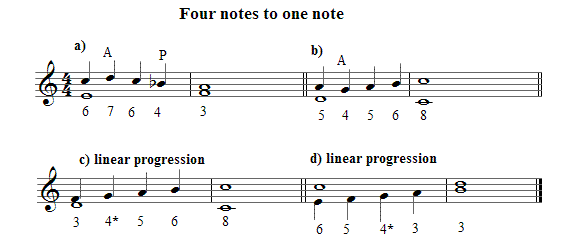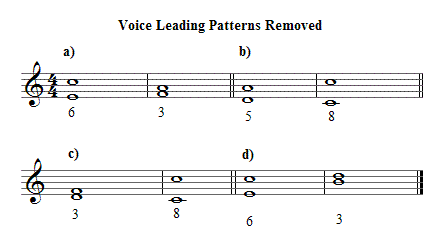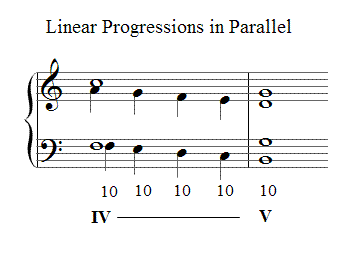APPENDIX A: VOICE LEADING OVERVIEW
Auxiliary Notes and Linear Progressions
If we take examples of counterpoint where one voice moves at four times the rate of the other, we get new possibilities in voice leading patterns, as we now have more rhythmic independence. This is sometimes referred to as Third Species counterpoint. This results in two new types of elaboration: the Auxiliary Note and the Linear Progression.

In this kind of counterpoint, one voice moves through four notes whilst the other voice stays on the same note. As in second species, the first beat of the four beats must be a consonant interval but dissonances can occur on other beats, as indicated in the above examples. This creates two new possible voice leading patterns, the auxiliary note and the linear progression.
The auxiliary notes are indicated by "A" in the examples. In a) the consonant interval of a 6th rises to the dissonant interval of the 7th. This returns immediately to the consonant 6th on the 3rd beat. This example also contains a passing note on the weak 4th beat, marked "P", passing from the consonant interval of a 6th to the consonant interval of a 3rd. In b) the interval of a 5th falls to the dissonant 4th and immediately returns to the consonant 5th.
This movement away from a harmony note to an adjacent note (consonant or dissonant) followed by a subsequent return is referred to as an auxiliary note. The auxiliary note may be above or below the consonant note and may be separated from the consonant note by a tone or a semitone. The auxiliary note normally (but not always) occurs on the week second beat.
Another possibility, in third species, is the linear progression. In c) and d) the consonant intervals on the first beats of the bars are interspersed with step by step movements. These are like a succession of passing notes and consequently the dissonance here may occur either on the second or third beat. In c) the dissonance occurs on the second (weak) beat but in d) the dissonance occurs on the strong 3rd beat of the bar. The point about the linear progression is that one or more parts move by successive contiguous steps whilst one or more voices stay stationary. Linear progression may ascend or descend.
These auxiliary notes and linear progressions are voice leading elaboration of the underlying consonant one to one movement. If we strip away this surface voice leading we are left with the following one to one movement:

Like other voice leading patterns, linear progressions and auxiliary notes can occur in various combinations when writing in more than two parts. These patterns are developed in later music to form different ways of elaborating underlying structural chords. The linear progression can move upwards or downwards and can occur in any voice: the melody, the bass part or any middle voice. In the following example two linear progressions move in parallel 10ths:

Linear progressions may create new chords on the way but these are in reality voice leading movements that decorate the underlying chord progression. In the above example, this is chord IV to V (assuming we are in a tonal key of C major). The following example shows a linear progression combined with an auxiliary note pattern:

The linear progression and auxiliary note patterns move in correct counterpoint with each other and are combined with arpeggiation in the middle voices. The voice leading here creates a cadential pattern and the underlying progression is from chord II to I, when expressed in terms of tonal functional harmony. We should remember that in 16th century polyphony they did not think in such terms. At that time, the cadence was the result of counterpoint rather than harmony.
In the 16th century, only diatonic linear progressions were used but later periods of music allow for chromatic varieties. See sections on Chromatic Linear Progressions and Chromatic Auxiliary Notes. See also book Chapter 3 Part 2 for more on Auxiliary Chords and book Chapter 4 for more on Linear Progressions.
Next Topic: Syncopation

